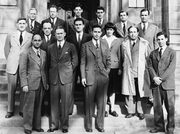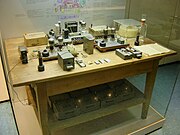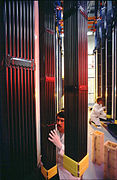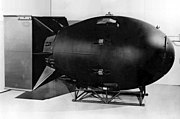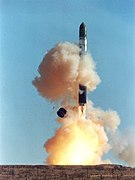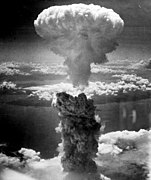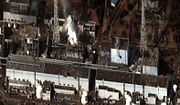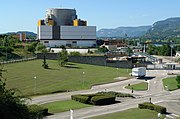Portal:Nuclear technology
The Nuclear Technology Portal

- Nuclear technology is technology that involves the nuclear reactions of atomic nuclei. Among the notable nuclear technologies are nuclear reactors, nuclear medicine and nuclear weapons. It is also used, among other things, in smoke detectors and gun sights. (Full article...)
- Nuclear power is the use of nuclear reactions to produce electricity. Nuclear power can be obtained from nuclear fission, nuclear decay and nuclear fusion reactions. Presently, the vast majority of electricity from nuclear power is produced by nuclear fission of uranium and plutonium in nuclear power plants. Nuclear decay processes are used in niche applications such as radioisotope thermoelectric generators in some space probes such as Voyager 2. Generating electricity from fusion power remains the focus of international research. (Full article...)
- A nuclear weapon is an explosive device that derives its destructive force from nuclear reactions, either fission (fission bomb) or a combination of fission and fusion reactions (thermonuclear bomb), producing a nuclear explosion. Both bomb types release large quantities of energy from relatively small amounts of matter. (Full article...)
The development effort initially focused on a gun-type fission weapon using plutonium called Thin Man. In April 1944, the Los Alamos Laboratory determined that the rate of spontaneous fission in plutonium bred in a nuclear reactor was too great due to the presence of plutonium-240 and would cause a predetonation, a nuclear chain reaction before the core was fully assembled. Oppenheimer then reorganized the laboratory and orchestrated an all-out and ultimately successful effort on an alternative design proposed by John von Neumann, an implosion-type nuclear weapon, which was called Fat Man. A variant of the gun-type design known as Little Boy was developed using uranium-235.
Chemists at the Los Alamos Laboratory developed methods of purifying uranium and plutonium, the latter a metal that only existed in microscopic quantities when Project Y began. Its metallurgists found that plutonium had unexpected properties, but were nonetheless able to cast it into metal spheres. The laboratory built the Water Boiler, an aqueous homogeneous reactor that was the third reactor in the world to become operational. It also researched the Super, a hydrogen bomb that would use a fission bomb to ignite a nuclear fusion reaction in deuterium and tritium.
The Fat Man design was tested in the Trinity nuclear test in July 1945. Project Y personnel formed pit crews and assembly teams for the atomic bombings of Hiroshima and Nagasaki and participated in the bombing as weaponeers and observers. After the war ended, the laboratory supported the Operation Crossroads nuclear tests at Bikini Atoll. A new Z Division was created to control testing, stockpiling and bomb assembly activities, which were concentrated at Sandia Base. The Los Alamos Laboratory became Los Alamos Scientific Laboratory in 1947. (Full article...)

- ... that the British Tychon missile was developed from a Barnes Wallis concept to keep strike aircraft safe while dropping nuclear bombs?
- ... that coral cores from Flinders Reef capture environmental changes caused by the use of nuclear weapons?
- ... that Helen Steven shared the Gandhi International Peace Award for her opposition to the nuclear submarine base in Scotland?
- ... that after journalist Adele Ferguson's criticism of the U.S. Navy's sex discrimination attracted nationwide attention, she was offered a personal tour of a nuclear submarine?
- ... that during World War II, pilot G. E. Clements was removed from training for secret missions associated with the Manhattan Project when senior officers realized she was a woman?
- ... that T. K. Jones thought that a nuclear war was survivable if "there are enough shovels to go around"?
| Parts of this portal (those related to section) need to be updated. Please help update this portal to reflect recent events or newly available information. Relevant discussion may be found on the talk page. (September 2021) |
Born in Walkerton, Indiana, Urey studied thermodynamics under Gilbert N. Lewis at the University of California, Berkeley. After he received his PhD in 1923, he was awarded a fellowship by the American-Scandinavian Foundation to study at the Niels Bohr Institute in Copenhagen. He was a research associate at Johns Hopkins University before becoming an associate professor of chemistry at Columbia University. In 1931, he began work with the separation of isotopes that resulted in the discovery of deuterium.
During World War II, Urey turned his knowledge of isotope separation to the problem of uranium enrichment. He headed the group located at Columbia University that developed isotope separation using gaseous diffusion. The method was successfully developed, becoming the sole method used in the early post-war period. After the war, Urey became professor of chemistry at the Institute for Nuclear Studies, and later Ryerson professor of chemistry at the University of Chicago.
Urey speculated that the early terrestrial atmosphere was composed of ammonia, methane, and hydrogen. One of his Chicago graduate students was Stanley L. Miller, who showed in the Miller–Urey experiment that, if such a mixture were exposed to electric sparks and water, it can interact to produce amino acids, commonly considered the building blocks of life. Work with isotopes of oxygen led to pioneering the new field of paleoclimatic research. In 1958, he accepted a post as a professor at large at the new University of California, San Diego (UCSD), where he helped create the science faculty. He was one of the founding members of UCSD's school of chemistry, which was created in 1960. He became increasingly interested in space science, and when Apollo 11 returned Moon rock samples from the Moon, Urey examined them at the Lunar Receiving Laboratory. Lunar astronaut Harrison Schmitt said that Urey approached him as a volunteer for a one-way mission to the Moon, stating "I will go, and I don't care if I don't come back." (Full article...)
- 9 May 2024 – Joint Comprehensive Plan of Action, Iran–Israel relations
- Iran warns that it will build a nuclear weapon if Israel continues to target its nuclear facilities. (Al Jazeera)
- 25 April 2024 – Russia–NATO relations
- Russian Deputy Foreign Minister Sergei Ryabkov warns that Russia will make NATO nuclear weapons in Poland one of its primary targets if they are deployed there. (The Jerusalem Post)
- 23 April 2024 – North Korea and weapons of mass destruction
- North Korea claims that it tested a new command-and-control system in a simulated nuclear counterstrike. (CNN)
The following Wikimedia Foundation sister projects provide more on this subject:
-
Commons
Free media repository -
Wikibooks
Free textbooks and manuals -
Wikidata
Free knowledge base -
Wikinews
Free-content news -
Wikiquote
Collection of quotations -
Wikisource
Free-content library -
Wikiversity
Free learning tools -
Wiktionary
Dictionary and thesaurus




